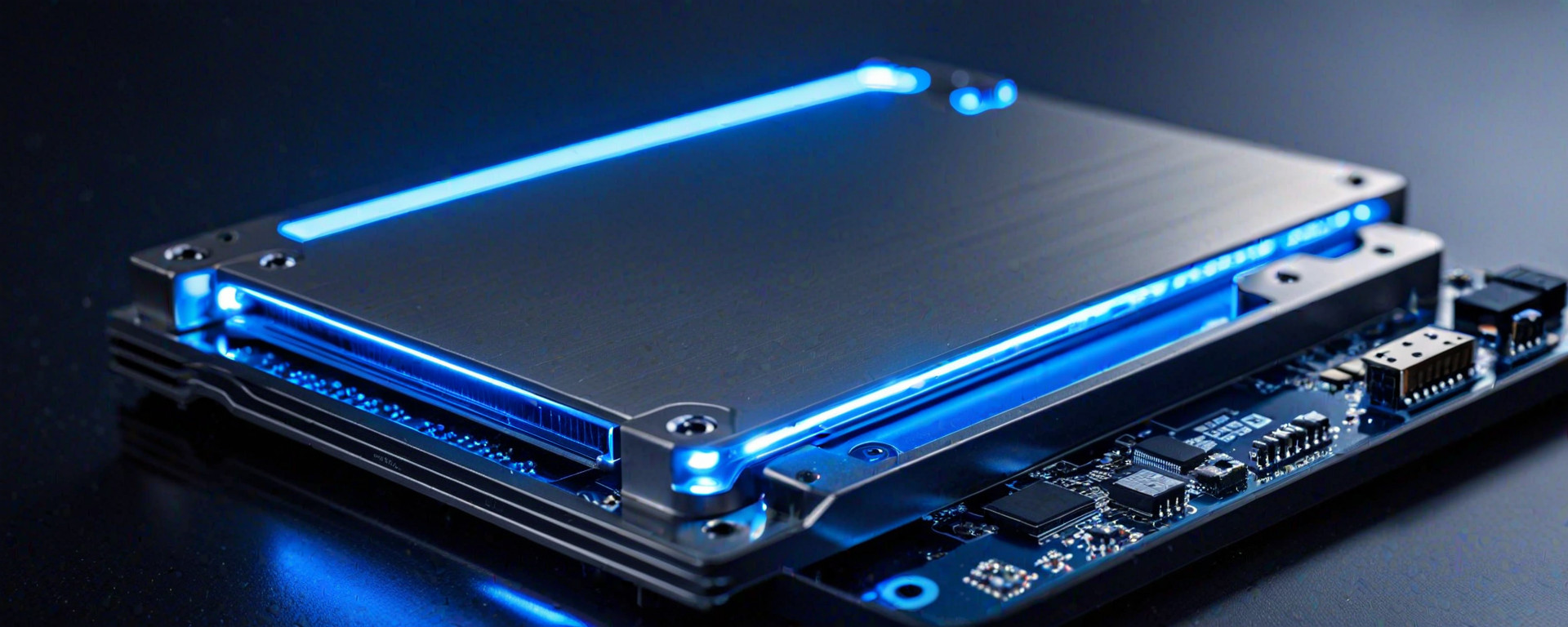Introduction
In today’s digital age, solid-state drives (SSDs) have become an essential component of computing devices due to their high performance and reliability. However, one aspect that often concerns users is the lifespan of these SSDs. Understanding how endurance affects SSD longevity and what TBW ratings mean can help you make informed decisions when purchasing an SSD for your system.
This article aims to provide a comprehensive guide on SSD endurance, focusing on key factors such as write amplification, garbage collection, and wear leveling. We will also explore the concept of TBW (Total Bytes Written) and how it compares with manufacturer warranties. By understanding these elements, users can choose an SSD that meets their performance requirements while ensuring long-term reliability.
Throughout this article, we will delve into detailed analyses of different aspects related to SSD endurance, including technical specifications, real-world usage scenarios, troubleshooting tips, and a comprehensive FAQ section. Our goal is to equip you with the knowledge necessary to make an informed decision when selecting an SSD for your computing needs.
Understanding SSD Endurance
Write Amplification
One of the primary factors affecting SSD endurance is write amplification, which refers to the amount of physical data written to the drive compared with logical data. Write amplification can occur due to various reasons such as garbage collection, wear leveling, and over-provisioning.
- Garbage Collection: This process involves collecting unused or invalid blocks of data from SSDs and merging them into free space. However, this increases the number of writes performed on the drive, thereby increasing write amplification.
- Wear Leveling: To ensure even wear across all NAND flash memory cells in an SSD, controllers use algorithms to distribute writes evenly. This process also contributes to higher write amplification.
Garbage Collection and Wear Leveling
Garbage collection and wear leveling are critical mechanisms that help extend the lifespan of SSDs by managing how data is stored and accessed on the drive. These processes ensure optimal performance and longevity, but they can also impact endurance.
- Garbage Collection: When a file is deleted or updated in an SSD, garbage collection identifies unused blocks and moves valid data to other areas of the NAND flash memory. This process creates free space for new writes but increases write amplification.
- Wear Leveling: Wear leveling algorithms distribute writes evenly across all cells within a block to prevent any single cell from experiencing excessive wear. While this helps extend the lifespan of SSDs, it can increase the overall number of writes over time.
Influence on Endurance and Performance
The efficiency of garbage collection and wear leveling directly influences the endurance and performance of an SSD. Effective management of these processes ensures that write amplification remains low, thereby extending the drive's lifespan.
- Performance: Efficient garbage collection reduces latency by minimizing the number of writes required for data access operations. This improves overall system responsiveness and I/O throughput.
- Endurance: By evenly distributing write operations across all memory cells, wear leveling maximizes the lifespan of an SSD. However, this can result in higher write amplification over time if not managed properly.
TBW (Total Bytes Written) Explained
Total Bytes Written (TBW) is a critical metric used to measure the expected lifetime of an SSD based on its ability to withstand writes. TBW represents the total amount of data that can be written to the drive before it reaches its maximum endurance limit.
Relationship with Manufacturer Warranties
The relationship between TBW and manufacturer warranties is crucial for understanding the expected lifespan of an SSD. Manufacturers typically provide a warranty based on either time or usage, which often correlates directly with the TBW rating of the drive.
- Time-Based Warranty: Some manufacturers offer warranties that guarantee the performance of their SSDs for a specific period (e.g., 5 years). This type of warranty does not necessarily correlate with actual write cycles but provides assurance based on expected usage patterns.
- Usage-Based Warranty: Other manufacturers base their warranties on TBW ratings, which specify the total number of bytes that can be written to the drive over its lifetime. For example, an SSD with a 100TB TBW rating is designed to handle up to 100 terabytes of data writes before reaching its endurance limit.
Impact on Longevity and Reliability
TBW ratings play a significant role in determining the longevity and reliability of an SSD. Higher TBW values indicate greater endurance, which is particularly important for workloads that involve frequent write operations such as database servers or virtual machines.
- Longevity: A higher TBW rating means the drive can sustain more writes over its lifetime, thereby extending its usable lifespan and reducing the frequency of replacements.
- Reliability: By adhering to strict endurance limits, SSDs with high TBW ratings ensure consistent performance and reliability even under heavy usage conditions. This is crucial for mission-critical applications where data integrity is paramount.
Selecting the Right SSD: Key Considerations
When choosing an SSD, several factors need to be considered beyond just capacity and speed. Understanding these key considerations will help you select a drive that meets your specific requirements while ensuring long-term performance and reliability.
Endurance Requirements
- Daily Write Volume: Assess the amount of data written daily on the SSD to estimate its endurance needs accurately. Applications with high write volumes require drives with higher TBW ratings.
- Expected Usage Duration: Determine how long you plan to use the SSD and select one that matches your expected usage pattern based on manufacturer warranties (time vs. usage).
Performance Metrics
- IOPS (Input/Output Operations Per Second): Measure the number of read/write operations an SSD can handle simultaneously, which is critical for applications requiring high throughput.
- Sequential Read/Write Speeds: Determine the maximum sequential data transfer rates for both reads and writes. This is important for tasks involving large file transfers or streaming media content.
Cost-Effectiveness AnalysisData Retention: SSDs with higher data retention capabilities are better suited for long-term storage applications where data integrity is crucial. Data retention measures the ability of an SSD to maintain stored data over extended periods without power.
Maximizing SSD Endurance and Performance
To get the most out of your SSD, it's essential to implement best practices that optimize endurance and performance. Here are some tips for maximizing the longevity and efficiency of your drive:
Data Management Strategies
- Defragmentation: Although modern SSDs do not require regular defragmentation like traditional hard drives, it can still be beneficial to run a lightweight utility periodically to optimize file placement.
- Trim Support: Enable TRIM functionality on your operating system to allow the SSD controller to manage unused blocks efficiently. This helps reduce write amplification and prolongs drive lifespan.
Advanced Configuration Settings
- Over-Provisioning: Configure over-provisioning by reserving a portion of the NAND flash memory for internal use. This enhances garbage collection efficiency, reduces write amplification, and improves overall performance.
- Write Caching: Enable or disable write caching based on your specific workload requirements to balance between performance and data integrity. Write caching can improve speed but may increase risk in case of power loss.
Troubleshooting Common Issues
Sometimes, SSDs may encounter issues that affect their performance or reliability. Here are some common problems along with troubleshooting steps:
Performance Degradation
- Cause: Over-Provisioning: Insufficient over-provisioning can lead to higher write amplification and slower performance.
- Action: Check Over-Provisioning Settings: Adjust the reserved space according to manufacturer recommendations or use SSD management software to optimize settings.
Data Loss or Corruption
- Cause: Power Failures: Sudden power outages can cause data corruption or loss, especially if write caching is enabled without proper safeguards.
- Action: Use Surge Protectors and UPS Systems: Implementing reliable backup solutions such as surge protectors or uninterruptible power supplies (UPS) helps prevent data loss due to unexpected power interruptions.
Frequently Asked Questions (FAQs)
Here are some common questions about SSD endurance, performance, and selection:
Q: How do I know if my SSD is reaching its end-of-life?
A: To determine if your SSD is nearing the end of its lifespan, monitor key metrics such as write amplification, read/write speeds, and error rates using specialized tools or built-in diagnostics provided by manufacturers. Look for significant performance drops or increased errors to identify potential issues.
Q: Can I extend the lifespan of my SSD through software optimizations?
A: Yes, implementing best practices such as enabling TRIM support, configuring over-provisioning, and managing data efficiently can help prolong the lifespan of your SSD by reducing write amplification and improving garbage collection.
Q: What is the difference between enterprise-grade and consumer-grade SSDs?
A: Enterprise-grade SSDs are designed for high-intensity workloads with higher endurance ratings, better error correction capabilities, and advanced features like power loss protection. Consumer-grade SSDs offer lower cost but may have fewer features tailored specifically for everyday use.
Conclusion
Understanding the intricacies of solid-state drive (SSD) performance and durability is crucial for ensuring optimal system efficiency and longevity. By carefully selecting an appropriate drive based on your specific needs, implementing best practices to maintain its health, and addressing potential issues promptly, you can maximize the benefits offered by SSD technology.
By following these guidelines and recommendations, you will be well-equipped to make informed decisions regarding SSD selection, maintenance, and troubleshooting, thereby enhancing both the performance and reliability of your computing environment.
Data Retention:
- SSDs with higher data retention capabilities are better suited for long-term storage applications where data integrity is crucial.
Maximizing SSD Endurance and Performance
To get the most out of your SSD, it's essential to implement best practices that optimize endurance and performance. Here are some tips:
Data Management Strategies
- Defragmentation: Although modern SSDs do not require regular defragmentation like traditional hard drives, running a lightweight utility periodically can help optimize file placement.
- Trim Support: Enable TRIM functionality on your operating system to allow the SSD controller to manage unused blocks efficiently. This helps reduce write amplification and prolongs drive lifespan.
Advanced Configuration Settings
- Over-Provisioning: Configure over-provisioning by reserving a portion of the NAND flash memory for internal use. This enhances garbage collection efficiency, reduces write amplification, and improves overall performance.
- Write Caching: Enable or disable write caching based on your specific workload requirements to balance between performance and data integrity. Write caching can improve speed but may increase risk in case of power loss.
Troubleshooting Common Issues
Sometimes, SSDs may encounter issues that affect their performance or reliability. Here are some common problems along with troubleshooting steps:
Performance Degradation
- Cause: Over-Provisioning: Insufficient over-provisioning can lead to higher write amplification and slower performance.
- Action: Check Over-Provisioning Settings: Adjust the reserved space according to manufacturer recommendations or use SSD management software to optimize settings.
Data Loss or Corruption
- Cause: Power Failures: Sudden power outages can cause data corruption or loss, especially if write caching is enabled without proper safeguards.
- Action: Use Surge Protectors and UPS Systems: Implementing reliable backup solutions such as surge protectors or uninterruptible power supplies (UPS) helps prevent data loss due to unexpected power interruptions.
Frequently Asked Questions (FAQs)
Here are some common questions about SSD endurance, performance, and selection:
Q: How do I know if my SSD is reaching its end-of-life?
A: To determine if your SSD is nearing the end of its lifespan, monitor key metrics such as write amplification, read/write speeds, and error rates using specialized tools or built-in diagnostics provided by manufacturers. Look for significant performance drops or increased errors to identify potential issues.
Q: Can I extend the lifespan of my SSD through software optimizations?
A: Yes, implementing best practices such as enabling TRIM support, configuring over-provisioning, and managing data efficiently can help prolong the lifespan of your SSD by reducing write amplification and improving garbage collection.
Q: What is the difference between enterprise-grade and consumer-grade SSDs?
A: Enterprise-grade SSDs are designed for high-intensity workloads with higher endurance ratings, better error correction capabilities, and advanced features like power loss protection. Consumer-grade SSDs offer lower cost but may have fewer features tailored specifically for everyday use.
Conclusion
Understanding the intricacies of solid-state drive (SSD) performance and durability is crucial for ensuring optimal system efficiency and longevity. By carefully selecting an appropriate drive based on your specific needs, implementing best practices to maintain its health, and addressing potential issues promptly, you can maximize the benefits offered by SSD technology.
By following these guidelines and recommendations, you will be well-equipped to make informed decisions regarding SSD selection, maintenance, and troubleshooting, thereby enhancing both the performance and reliability of your computing environment.








